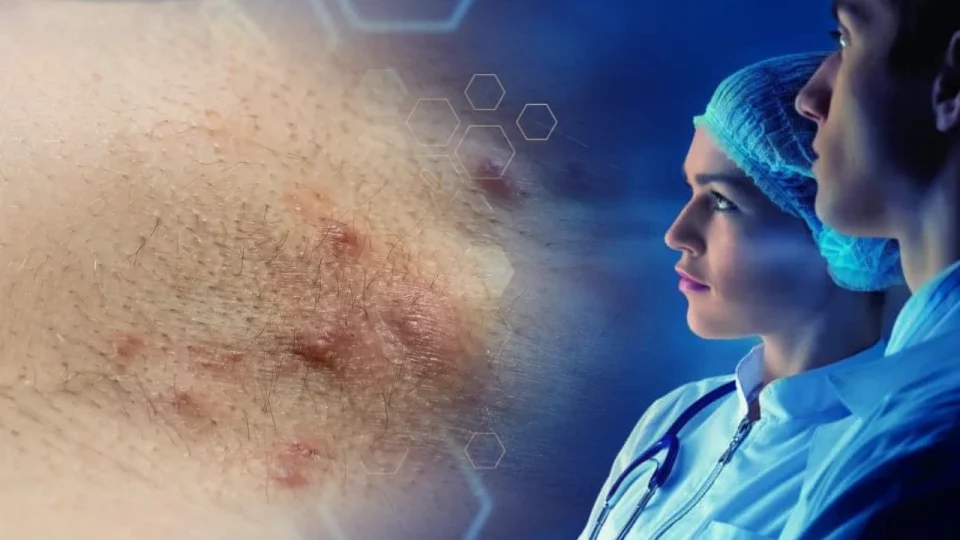Skin conditions often come with physical discomfort, emotional stress, and sometimes, social stigma. Among these, hidradenitis suppurativa (HS) stands out not only for its painful and persistent nature but also for its notorious difficulty in being correctly diagnosed.
Despite being a chronic autoinflammatory skin disease, hidradenitis suppurativa often masquerades as more common and less severe conditions, delaying treatment and compounding the challenges for patients.
Table of Contents
What Is Hidradenitis Suppurativa?
Hidradenitis suppurativa, also known as acne inversa, is a chronic skin condition that causes painful nodules, abscesses, and scarring. It typically affects areas where skin folds, such as the armpits, groin, buttocks, and under the breasts. While it might initially appear similar to acne or folliculitis, the underlying mechanisms are far more complex.
Unlike acne, which largely affects the surface of the skin, hidradenitis suppurativa begins deeper, involving the hair follicles and associated sweat glands. These glands become inflamed and blocked, triggering a cascade of painful symptoms. According to Dr. Nicole Lee, a board-certified dermatologist, “It’s not just the follicle, but also the associated sweat gland. And those glands are what allow this larger, deeper, more inflammatory process.”
Key characteristics of hidradenitis suppurativa include:
- Painful lumps that can persist or recur in the same areas.
- Abscesses that drain fluid or pus.
- Scarring and tunneling beneath the skin in severe cases.
- A chronic course that worsens if left untreated.
Understanding these symptoms is crucial, as they often overlap with other, less severe conditions, making a definitive diagnosis difficult.
Why Is Hidradenitis Suppurativa So Difficult to Diagnose?
One of the greatest challenges in managing hidradenitis suppurativa is obtaining an accurate diagnosis. Many patients go years without understanding their condition, enduring misdiagnoses and ineffective treatments that allow the disease to progress. Several factors contribute to this diagnostic difficulty:
1. Overlapping Symptoms with Other Conditions
Hidradenitis suppurativa shares symptoms with several more common skin conditions, leading to frequent misdiagnoses. For instance:
- It is often mistaken for acne due to the presence of boils and nodules.
- Some patients are told they have a recurrent staph infection or folliculitis, conditions that are more easily treated and not chronic in nature.
According to Dr. Gibran Shaikh, a dermatologist and clinical instructor at Mount Sinai, many patients are misled by hygiene-related advice. “A lot of times, people go to the emergency department and they’re told, ‘Oh, you have a boil, you need to wash yourself or shower more.’ This is not that.”
Misdiagnoses like these create what Dr. Shaikh refers to as anchoring bias—a fixation on an initial, incorrect diagnosis that delays proper treatment and exacerbates the disease.
2. The Role of Subtle and Episodic Symptoms
Another barrier to early diagnosis is the condition’s subtle onset and variable progression. Unlike conditions with a clear and immediate presentation, hidradenitis suppurativa can manifest as sporadic episodes of lumps or abscesses that may seem unrelated.
Dr. Shaikh explains, “You might be like, ‘Oh, I had this thing under my arm for a few weeks, like three years ago, and then it kind of went away, and then recently I got a spot just popping up in my groin.’” This irregular pattern often prevents patients and non-specialist healthcare providers from connecting the dots.
Additionally, much of the disease occurs beneath the skin, making it less visible and more challenging to identify during routine exams.
3. Limited Awareness Among Non-Specialists
Hidradenitis suppurativa requires a trained eye to diagnose, yet many patients first seek help from general practitioners or urgent care providers who may lack the specialized knowledge needed to recognize the condition.
“Dermatologists can and will more than likely get it right,” says Dr. Shaikh. “But the problem is that a lot of people tend to go instead to their primary doctor or local urgent care.” These providers may attribute symptoms to simpler conditions, further delaying a correct diagnosis.
Path to Diagnosis and Treatment
Despite its challenges, hidradenitis suppurativa can be managed effectively with the right approach. Here’s what patients and doctors should keep in mind:
1. Seek Specialized Care
Hidradenitis suppurativa is best diagnosed and treated by a dermatologist. Diagnosis is based entirely on a clinical examination and patient history. Specialists can recognize the subtle signs that differentiate HS from other conditions.
2. Advocate for Yourself
Patients should trust their instincts and advocate for their health. Keeping a record of symptoms, including their frequency and severity, can provide valuable information to a doctor.
3. Explore Treatment Options
While there’s no cure for hidradenitis suppurativa, a range of treatments can help manage symptoms and prevent progression, including:
- Medications, such as antibiotics, retinoids, or biologics like adalimumab.
- Lifestyle changes, including weight management and smoking cessation, which may reduce flare-ups.
- Surgical interventions for severe cases, such as drainage procedures or removal of affected skin.
4. Build a Support Network
Living with HS can be isolating, but support groups and online communities provide a space for patients to share experiences, advice, and encouragement.
